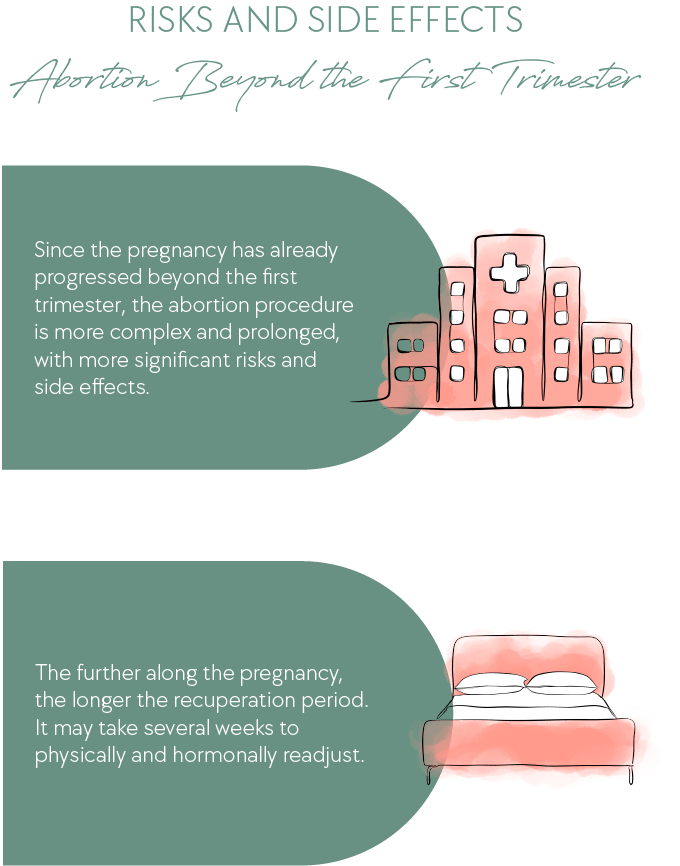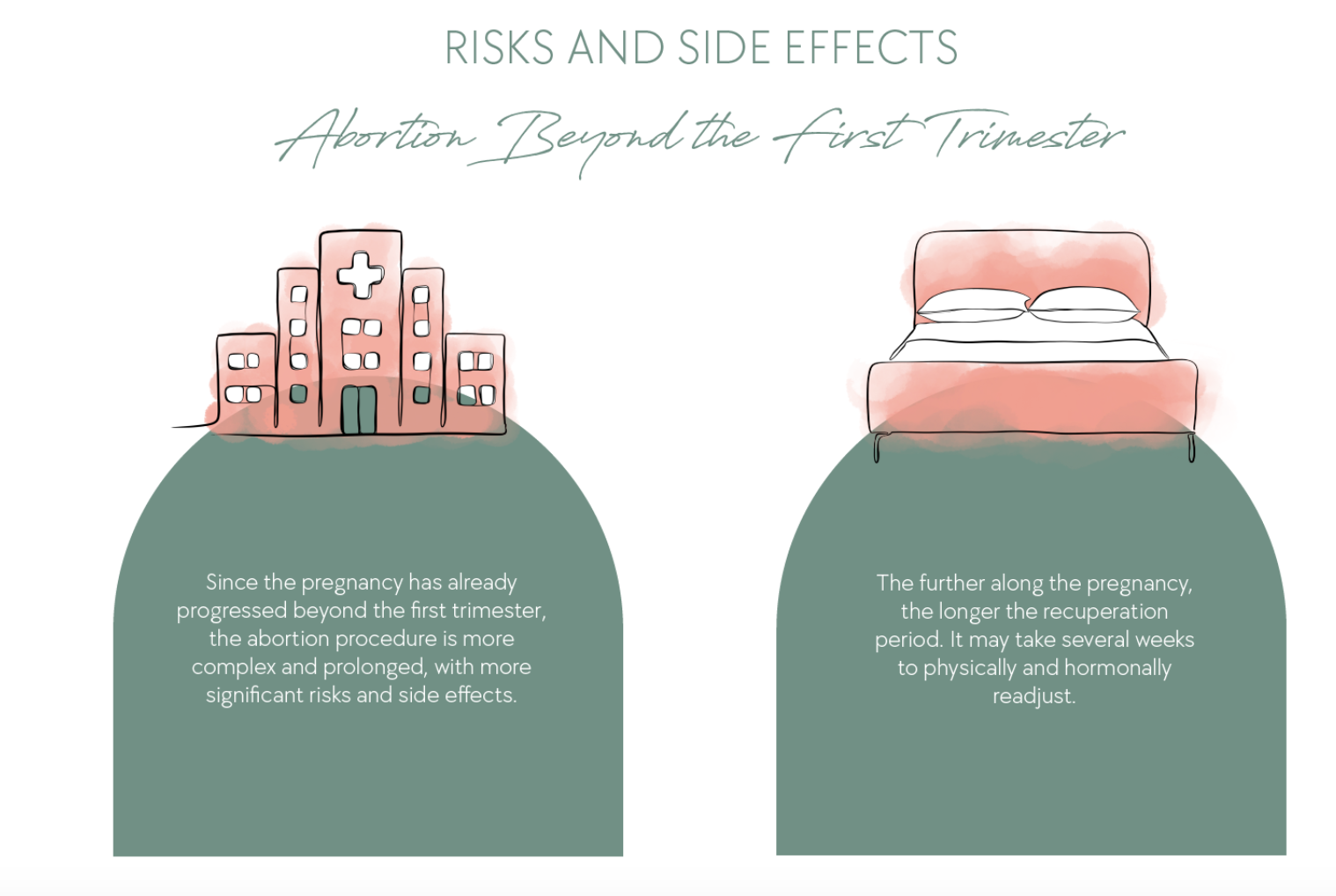What Is a Late Termination of Pregnancy, and When Is It Legal?
- Late-term abortion refers to any abortion performed after the first trimester. This is a colloquial rather than a medical term.
- In most areas, exceptions allow for abortions until birth, such as rape, incest, and the mother's health.
- Late-term abortions require methods other than those used within the first 12 weeks.
📖 This article provides information on late-term abortions (e.g., gestational limits and abortion methods).
- ⚖️ Wondering whether to have an abortion or not? – Take the Abortion Test
What Are Late-Term Abortions, and How Far Along in Pregnancy Can You Have One?
A late-term abortion is understood as a termination of pregnancy performed after the first trimester (i.e., after the first 12 weeks of pregnancy). According to CDC's Abortion Surveillance 2021 statistics, 6.6% of US abortions are performed after week 13. Theoretically, abortions are possible up until birth. A distinction is usually made between:
- Second-trimester abortions, ending at viability* at around 24 weeks,
- And third-trimester abortions, starting around week 25.
*Viability is the stage at which survival outside the womb is possible.
When Is It Legal to Have a Late-Term Abortion?
If you live in an area with a threshold restriction for late-term abortions, specific reasons must be provided that allow for an exception.
Conditions for Late-Term Abortions
If a doctor deems an abortion necessary to save the mother's life, abortion is permitted in most countries, even where abortion is illegal. Other indications that may allow for a late abortion are socioeconomic, the health of the mother, fetal anomalies, rape, or incest.
This table provides you with information on late-term abortion exceptions in your region. The numbers indicate the time limit for abortion in weeks of gestation, counting from your last menstrual period (LMP), according to the specific reason provided.
-
Region Regular Limit Fetal Defect Rape Mother's Health Mother's Life Alabama banned banned banned banned unlimited Alaska unlimited unlimited unlimited unlimited unlimited Arizona 15 Weeks LMP 15 Weeks LMP 15 Weeks LMP 15 Weeks LMP Unlimited Arkansas banned banned banned permitted beyond viabilty unlimited California viability viability viability viability unlimited Colorado unlimited unlimited unlimited unlimited unlimited Connecticut viability viability viability viability unlimited Delaware viability viability viability viability unlimited Florida 6 Weeks LMP unlimited extended extended unlimited Georgia 6 Weeks LMP 6 Weeks LMP extended 6 Weeks LMP unlimited Hawaii viability viability viability viability unlimited Idaho banned banned permitted banned unlimited Illinois viability viability viability viability unlimited Indiana banned 20 weeks 14 weeks if under 16; 10 weeks if 16 or older permitted unlimited Iowa 6 weeks (Fetal Heartbeat) permitted Rape: within 45 days of incidence
Incest: within 140 dayspermitted but highly restricted unlimited Kansas 22 Weeks LMP 22 Weeks LMP 22 Weeks LMP 22 Weeks LMP unlimited Kentucky banned banned banned banned unlimited Louisiana banned permitted banned banned unlimited Maine viability viability viability viability unlimited Maryland viability viability viability viability unlimited Massachus 24 Weeks LMP 24 Weeks LMP 24 Weeks LMP 24 Weeks LMP unlimited Michigan 24 Weeks LMP 24 Weeks LMP 24 Weeks LMP 24 Weeks LMP unlimited Minnesota viability viability viability viability unlimited Mississippi banned banned permitted banned unlimited Missouri banned banned banned banned unlimited Montana viability viability viability viability unlimited Nebraska 12 Weeks LMP permitted 12 Weeks LMP 12 Weeks LMP unlimited Nevada 24 Weeks LMP 24 Weeks LMP 24 Weeks LMP 24 Weeks LMP unlimited N. Hampsh. 24 Weeks LMP 24 Weeks LMP 24 Weeks LMP 24 Weeks LMP unlimited New Jersey unlimited unlimited unlimited unlimited unlimited N. Mexico unlimited unlimited unlimited unlimited unlimited New York viability viability viability viability unlimited N. Carolina 12 Weeks LMP permitted permitted 12 Weeks LMP unlimited N. Dakota banned banned banned banned unlimited Ohio viability viability viability unlimited (12/08/23) unlimited Oklahoma banned banned banned banned unlimited Oregon unlimited unlimited unlimited unlimited unlimited Pennsylv. 24 Weeks LMP 24 Weeks LMP 24 Weeks LMP 24 Weeks LMP unlimited Rhode Is. viability viability viability viability unlimited S. Carolina 6 Weeks LMP permitted permitted permitted unlimited S. Dakota banned banned banned banned unlimited Tennessee banned banned banned banned unlimited Texas banned banned banned banned unlimited Utah 18 Weeks LMP 18 Weeks LMP 18 Weeks LMP 18 Weeks LMP unlimited Vermont unlimited unlimited unlimited unlimited unlimited Virginia 26w + 6d LMP 28 Weeks LMP 28 Weeks LMP 28 Weeks LMP unlimited Washington viability viability viability viability unlimited Wash. DC unlimited unlimited unlimited unlimited unlimited W. Virginia banned banned banned banned unlimited Wisconsin banned banned banned banned unlimited Wyoming viability viability viability viability unlimited -
Region Regular Limit Fetal Defect Rape Mother's Health Mother's Life Great Britain 24 Weeks LMP unlimited 24 Weeks LMP 24 Weeks LMP unlimited Northern Ireland 24 Weeks LMP unlimited 24 Weeks LMP 24 Weeks LMP unlimited Ireland 12 Weeks LMP 15 Weeks LMP 12 Weeks LMP 24 Weeks LMP Unlimited -
Region Regular Limit Fetal Defect Rape Mother's Health Mother's Life ACT unlimited unlimited unlimited unlimited unlimited NSW 22 Weeks LMP unlimited 22 Weeks LMP 22 Weeks LMP unlimited NT 14 Weeks LMP 23 Weeks LMP 23 Weeks LMP 23 Weeks LMP Unlimited QLD 22 Weeks LMP 22 Weeks LMP 22 Weeks LMP 22 Weeks LMP unlimited SA (2022) 22w + 6d LMP unlimited 22w + 6d LMP unlimited unlimited TAS 16 Weeks LMP 16 Weeks LMP 16 Weeks LMP 16 Weeks LMP Unlimited VIC 24 Weeks LMP 24 Weeks LMP 24 Weeks LMP 24 Weeks LMP unlimited WA 20 Weeks LMP 20 Weeks LMP 20 Weeks LMP 20 Weeks LMP unlimited -
While abortion is unrestricted throughout Canada, availability differs from state to state. Here you can find out until when abortion is offered in your region:
Region Available Until Alberta 20 Weeks LMP British Columbia 24w + 6d LMP Manitoba 16 Weeks LMP New Brunswick 16 Weeks LMP Newfoundland & Labrador 16 Weeks LMP Northwest Territories 20 Weeks LMP Nova Scotia 16 Weeks LMP Nunavut 19w + 6d LMP Ontario 23w + 6d LMP Prince Edward Island 12 Weeks LMP Quebec 24 Weeks LMP Saskatchewan 18w + 6d LMP Yukon 12w + 6d LMP -
Region Regular Limit Socio-economic Reasons Fetal Defect Rape / Mother's Health Mother's Life New Zealand 20 Weeks LMP 20 Weeks LMP unlimited unlimited unlimited South Africa 13 Weeks LMP 20 Weeks LMP unlimited 20 Weeks LMP unlimited -
Europe:
Click here for an overview of abortion regulations in each European country. You can also read further information on our Profemina pages for these countries:
- Austria: Spätabtreibung: ja oder nein?
- Germany: Spätabtreibung: ja oder nein?
- Italy: Aborto terapeutico: sì o no?
- Portugal: Abortar em caso de deficiência
- Switzerland: Spätabtreibung: ja oder nein?
Region Regular Limit Fetal Defect Rape Mother's Health Mother's Life Cambodia 12 Weeks LMP unlimited unlimited unlimited unlimited Mexico 15 Weeks LMP possible unlimited unlimited unlimited Netherlands 24 Weeks LMP 24 Weeks LMP unlimited 24 Weeks LMP unlimited Thailand 12 Weeks LMP 20 Weeks LMP 20 Weeks LMP 20 Weeks LMP unlimited
2nd and 3rd Trimester Abortions
-
Legal parameters for abortions are usually given with the mother's well-being in mind. The risk of a late-term abortion is weighed against the trauma of the abortion indicator. Therefore, socio-economic reasons and general health concerns are commonly accepted as abortion indicators in early pregnancy only. Conversely, if the mother’s life is in danger, she is always permitted to have an abortion.
-
The severity of fetal defects is usually considered. Abortions are often limited to defects that would drastically shorten the child's lifespan.
For more information, go to When is an Abortion Performed to Save the Life of the Mother?
Abnormal findings or detection of disability would make you feel like your world has been flipped upside down. Dreams and plans come to a standstill as the situation takes on an enormous weight.
It is natural to desire your child to be healthy—this shows you care!
Maybe you just had a stressful experience at a prenatal examination and came upon this article hoping to find clear answers.
🩺 Facing the question of whether to have a fetal defect abortion or not? – Take the Self-Assessment!
🕰 If you are facing this decision, you probably still have time to envision several different scenarios of what your future could look like.
However, many women say they feel like they are running a marathon—battling their hopes and fears. Your medical provider may have also given the impression that you must decide and act quickly.
Process of Late-Term Abortions
Should a woman fall within the spectrum of exceptions and choose to pursue a late termination of pregnancy, the following steps can be expected:
- It is usually necessary for a doctor to diagnose a medical indication for abortion.
- Frequently, informed consent is required. In this case, a state-mandated counselor will present you with information on all your options to ensure that your decision is given due deliberation.
- Unless urgent medical intervention is necessary, state-regulated waiting periods of three to seven days are often implemented.
- A blood test and an ultrasound are often performed at a preliminary appointment.
Late-Term Abortion Methods
Late terminations of pregnancy, performed after the first trimester, require their own methods. Neither medical abortions via the abortion pill, D&Cs, nor vacuum aspirations are used past the first 12–14 weeks.
Three methods are available for late-term abortions:
Dilation and Evacuation – D&E (Uterine Suction Curettage)
This is a surgical procedure using vacuum aspiration performed in the second trimester. A suction catheter removes the amniotic fluid. Using forceps, the fetus is then dismembered and extracted in pieces from the womb. Finally, suction and curettage is performed to ensure that all fetal material has been removed.
94-98% of second-trimester abortions, of which 92% are under 20 weeks, are performed via D&E (UpToDate 2022).
Medications are used to start the process of labor and delivery. If the fetus is too young to survive outside the womb, it usually dies during the birthing process. Once the fetus has reached 22 weeks and could potentially be born alive, a potassium chloride injection is given to stop its heartbeat. This leads to fetal demise.
This procedure can be performed in the second and third trimester of pregnancy.Induction abortions account for most other second and third-trimester abortions (2-6% of late-term abortions). Unlike the other abortion methods, which are outpatient, inductions usually require a two- to three-day hospital stay.
- Dilation and Extraction – D&X
Before using this procedure in the US, the fetus must be given an injection to stop its heartbeat. It is then delivered feet first, with the head remaining inside the woman’s body. Scissors are inserted in the back of the fetus' neck creating a hole. The baby’s brain is then suctioned out and the head collapsed, reducing the head circumference for removal.
This procedure can be performed in the second and third trimester of pregnancy.
🏥 Abortion Methods: What do I need to know? — Take the Test!


Pregnant After the First Trimester and Searching for Answers…
You may be facing the decision of whether to have a late-term abortion. Your pregnancy may have taken an unexpected turn. This is something you could not have foreseen. Or perhaps you only just found out you were pregnant. Since you are already beyond the first three months of pregnancy, you are now considering a late termination of pregnancy…
Several aspects play a role in making a late-term abortion more difficult than an early termination:
- The further along you are in the pregnancy, the greater the risks and side effects.
For more details, go to Risks and Side Effects of Late-Term Abortions. Knowing that the baby is close to, or even beyond, the point at which it could survive outside the womb also adds a greater emotional component.
🛤 Are you concerned whether an abortion could affect you long term? — Take the Test
You are probably under immense pressure right now. Many women in your shoes have had the experience that the people around them felt at a loss for words and did not know how to respond.
Our desire for you is that you would not be left stranded but that you would receive the care you deserve. That is why we have compiled resources that are tailor-made for your situation.
- ⚖️ Late-term abortion: Yes or no? Take the Abortion Test and receive an immediate evaluation.
- 💡 Your greatest concern —Take the Solutions Finder Test.
The Stats: Late-Term Abortions
It is estimated that 10–15% of abortions worldwide happen after the first trimester (Reproductive Health Matters, 2010).
In 2021, 5.7% of abortions in the US were performed in the second trimester, and 0.9% of abortions were performed within the third trimester (CDC Report 2023).
Our Top Picks for You:
Disclaimer:
While we strive to provide you with the most up-to-date information possible, abortion regulations are constantly shifting. Profemina takes no responsibility for the accuracy of the numbers provided.























